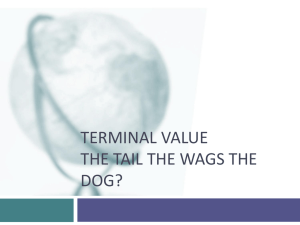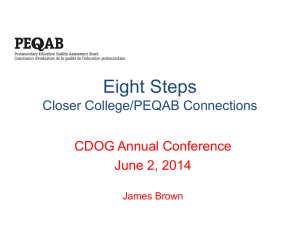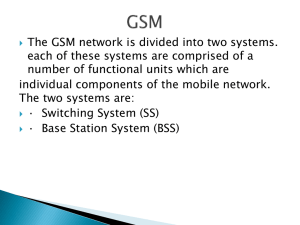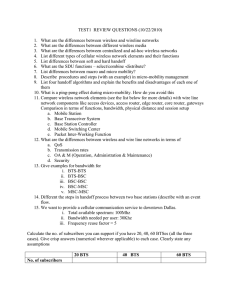courseOverview
advertisement
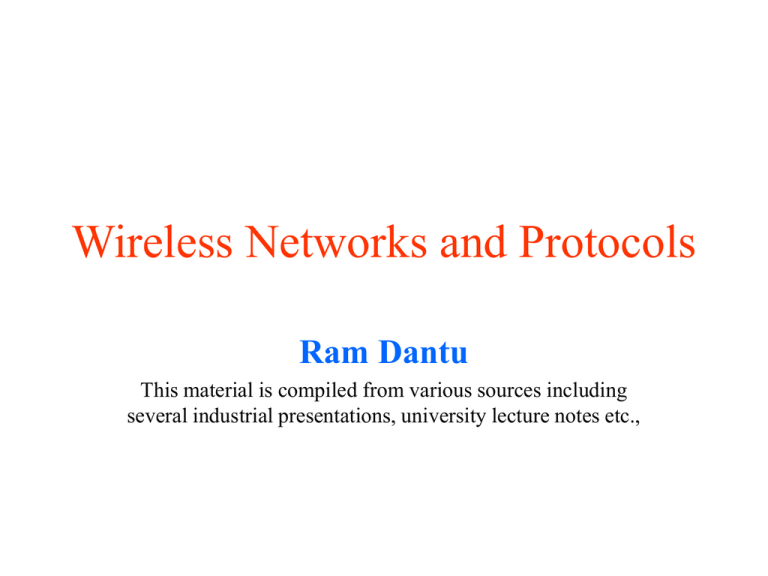
Wireless Networks and Protocols Ram Dantu This material is compiled from various sources including several industrial presentations, university lecture notes etc., Why Wireless? Reduced cost • More flexibility for locating equipment (deployment ease) • User mobility • Reduced space needed for cabling • Provision for location information/location-based applications • More suitable for broadcasting • Limitations of Wireless Capacity reduction: reduced data rates, increased blocking • Spotty coverage • Variability in network performance • Energy constraints • The Wireless Media Signal paths between a transmitter and a receiver can contain physical obstructions. The presence of these multiple paths and/or physical obstructions implies fading. The Wireless Media (continued) Furthermore, fading can vary in time, frequency, and space (for example, as users move). In addition to fading, wireless transmissions are susceptible to interference from other users and/or systems. Consequently, the wireless media can significantly impact the transmission and reception of signals (much more so than transmissions on wired networks). Implications Thus, network protocols designed assuming wired channel characteristics may not perform well in wireless scenarios. Wireless networks should be designed and studied for the wireless channel. ➢ Considerations in Design and Study How are networks used? • What are the capabilities of the network elements? • What information is available to network elements? • How to jointly exploit the information and capabilities of elements? • And so on • Centralized vs Non-centralized Centralized wireless networks have two types of transceivers: access points (AP's) and user terminals. AP's have wired connections to other AP's and/or larger wired networks. This implies control is centralized at the AP's, i.e., user terminals communicate only to AP's -> a spoke-and-wheel network configuration Non-centralized networks can also contain both AP's and user terminals but communication is not limited between AP and user terminals only. Ad hoc, peer-to-peer connections are possible, as is dynamic routing of information from source to destination. Cellular Services or Features: Voice and data through handheld phones. Coverage Area: Continuous coverage. At times limited to metropolitan regions. Limitations: Available bandwidth is very low for most data intensive applications. Examples: AMPS, IS-136, IS-95, GSM, WCDMA, cdma2000, etc. Wireless Local Area Networks (WLAN's) Services or Features: Traditional LAN extended with wireless interface Coverage Area: Used only in local environments Limitations: Limited range. Examples: IEEE 802.11 suite (a,b,g) Global Positioning System (GPS) Services or Features: Helps to determine the three-dimensional position, velocity, and time. Coverage Area: Anyplace on earth. Limitations: Cost. Examples: GNSS, NAVSTAR, GLONASS Satellite Based PCS Services or Features: Voice paging and messaging. Coverage Area: Almost anyplace on earth. Limitations: COST! Examples: Iridium, Teledesic. TDMA Operation • Fixed-assisgnment multiple access (FAMA): This assignment of capacity within the overall satellite channel is distributed in a fixed manner among multiple stations. • Transmission in the form of repetitive sequence of frames – Each frame is divided into a number of time slots – Each slot is dedicated to a particular transmitter • Earth stations take turns using uplink channel – Sends data in assigned time slot • Satellite repeats incoming transmissions – Broadcast to all stations • Stations must know which slot to use for transmission and which to use for reception FAMA-TDMA Uplink FAMA-TDMA Downlink Home Networking Services or Features: To connect different PC's in the house to share files and devices such as printers. Also to connect different appliances in the house. Coverage Area: Anywhere in the house. Limitations: Limited to a home. Examples: HomeRF. This can also be categorized as a local area network. Ad Hoc Networks Services or Features: Group of users share data with each other for a short period of time. Coverage Area: Equal to that of a LAN, but without fixed infrastructure. Limitations: Limited range. Examples: Bluetooth, defense applications. Battlefields, disaster locations. Sensor Networks Services or Features: A large number of tiny (cheap, low-power) sensors with wireless capabilities. Collected data is transmitted back to a central processor. Coverage Area: Relatively small terrain. Limitations: Very limited range, scalability problems (under certain circumstances). Examples: Defense and civilian applications. Monitor inhospitable or inaccessible terrain. A Simple Wireless Network Mobile Data Set Base Station Controller (BSC) Mobile Switching Center (MSC) PSTN Mobile Voice Unit Packet Network Base Transceiver System (BTS) Packet InterWorking Function Challenge is to keep connection and not loose any data during handoff operation The Components • BTS – BTS consists of one or more transceivers placed at a single location. The BTS terminates the radio path on the network side. • BSC – Provides allocation and management of radio resources. – SDU: Selection and distribution unit. Also responsible for handoff coordination • MSC – Provides and controls mobile access to the PSTN. Interprets the dialed number, routes and switches call to destination number. Also manages mobile’s supplementary services. Maintains a register of visitors operating within the coverage area of the MSC’s connected BTSs. • PDSN: Packet data service node is basically a packet router. Current Wireless Network Architecture MSC PDSN TDM channels Packets BSC (SDU) BSC (SDU) BSC BSC (SDU) TDM channels in the central office BTS 24xDs0 in T1 - Backhaul cost is by $$$/mile - 10-100 miles between BTS and BSC - Voice or data use one DS0 channel at a time - BTSs are located in the tower - BSC and MSCs are located BTS BTS BTS BTS BTS Soft Handoff between two BTS Handoff: A handoff mechanism is needed to maintain connectivity as devices move, while minimizing disruptions to ongoing calls. This mechanism should exhibit low latency, incur little or no data loss, and scale to a large network.” Handoffs == ( Hard || Soft ) -85.2 34 33.9 highway Rural Urban 33.8 Typi US c 33.7 BTS 30x3 33.6 mile 33.5 33.4 33.3 33.2 33.1 -85 -84.8 -84.6 -84.4 -84.2 -84 2G/3G RAN Network (Traditional) Interoffice distance (costs per mile) cost + Fixed Cost CO CO CO CO Channel Termination Cost Channel Termination Cost BSC MSC BTS BTS BTS BTS BTS BTS SDU and soft handoff - 3 to 6 BTSs involved in soft handoff - SDU changeover due to weak signal from primary BTS - BTS forwards even corrupted radio frames to the SDU for selection SDU -2 WR-B WR-A BTS-2 SDU -2 BTS-1 SDU SDU-1 -1 BTS-3 What happens when a cellular user turns on their phone? Terminal scans control channels and locks on to strongest one. If can’t find a strong enough signal, “no service” With receiver turned to strongest control channel, terminal extracts important information from broadcast channel. Strongest Signal On interpreting this broadcast information, terminal turns on “roaming” sign, determines DCC, paging channels, etc. Once this initialization is complete, mobile enters idle mode. When no call in progress, terminal monitors paging messages in order to detect arrival of a new call. Page for User with MIN X Paging Channel (one of broadcast channels) User with Mobile Identification Number (MIN) X Power consumed by radio receiver while it waits for paging message has strong influence on standby time of terminal’s battery. Terminals can operate in sleep mode when no call in progress. In this mode, terminal turns off its receiver for significant fraction of time. Wakes up for short period of time. If there is paging message for terminal, BS schedules message to arrive during brief wake-up interval. This is synchronized by using a hyperframe counter. Paging messages arrive in SPACH blocks of superframe. Indicates assigned traffic channels, etc. How does system deal with roaming users? Aside from connecting radio system to public/private wired networks, MSC also connects to two types of databases (DBs): • Home Location Registers (HLRs) • Visitor Location Registers (VLRs) BS MSC BS HLR VLR BS MSC BS Private, Public, Residential Networks HLR contains subscription information of a set of terminals and also records terminal’s current location and status. Information about each terminal is accessed using mobile identification number. A call request for a terminal arrives at terminal’s home MSC. Home MSC interrogates HLR in order to determine location of terminal. MSC then coordinates actions to page terminal in visited system. VLR stores information about terminals currently in service area. This information is used to setup calls initiated by cellular users And to deliver calls directed to cellular users. Service area of VLR Spans coverage areas of one or more MSC’s. Mobility Management • Mobility management procedures begin when system detects visting terminal. • When mobile is in coverage area of base, it will at some point send either a registration message or origination message (when making a call) to BS. • BS will inform MSC which will register user’s presence at VLR. • VLR notifies terminal’s HLR of terminal’s location. • Whenever terminal that does not have a call in progress enters a new location area, it sends a registration message to local base station. • Location areas are clusters of contiguous cells. • When a call arrives for a terminal, system pages terminal only in the location area where it last registered. • Registration tradeoff: if terminal registers often, it is easier to locate the terminal but it uses up resources. How are Handoffs Coordinated? Mobile Assisted Handoff (MAHO) A terminal tuned to a digital traffic channel relies on MAHO to move Its call to a new BS. With MAHO terminal with call in progress monitors quality of Signal on active traffic channel. During intervals in each frame when it is not required to transmit/ Receive information on active traffic channel, terminal measures Strength of signals received from surrounding BS. Terminal reports measurements to its own BS on SACC. MSC and BS control procedure by transmitting “measurement Order” and “stop measurement order” messages to terminals With calls in progress. “Measurement order” messages identify active channels in Surrounding cells. Terminal tunes to these channels and Observes signal strengths. Terminal measures bit error rate (BER) and received signal Strength indication (RSSI). MAHO monitors quality of signal received at terminal as well as At BS. Can react promptly to signal-quality problems. When signal at another BS exceeds current for some period Of time, MSC coordinates between two BS to switch user to New BS. Switch requires terminal to tune into new channel. Access Techniques TIME TIME User 3 1 2 3 User 2 User 1 FREQUENCY FREQUENCY TDMA FDMA CODE TIME User 3 User 2 User 1 FREQUENCY CDMA o r “Spread Spectrum” Spatial Diversity Cellular Systems • Early Mobile Radio Systems – single high powered transmitters – good coverage, but impossible to reuse same frequency (e.g., Bell Mobile System ‘70 -- max 12 calls over thousand sq. Miles) – it was impossible for the FCC to allocate new spectrum with the growing demand Cellular Systems • Cellular Concept – technique of using a fixed a number of channels to serve an arbitrary large number of subscribers by reusing channels throughout the coverage area – high system capacity in a limited spectrum – many low powered transmitters (small cells) – each base station allocated a portion of the spectrum Modeling radiation pattern R R R • Which one is the best model? R R Desirable Topologies cluster size (N = 3) Desirable Topologies (N = 4) Desirable Topologies (N = 5) Desirable Topologies N=7



